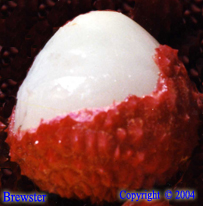From reading the original booklet hindsight makes it obvoius that there
was still much to be learned about Litchi, both in Florida and internationally.
At the time it was published, and reprinted, it represented and provided the
most up to date information for rarefruiters and homeowners on a new and
promising tree. Much work has been done but a surprising number or original
questions still remain unanswered. New methods are developing to regulate
fruiting and new work is being done to find varieties suited to specific micro
climates. DNA analysis is being used to show complex inter-relationships between
varieties and some of these varieties have been found to be the same plant
growing under more than a single name.
It turns out that the first time I moved to SW Florida I lived about
two miles from "Laurel Groves" which was what survived in the early eighties
of William Groves plantings. There were beautiful old Litchi and a few other
fruits. The obvious age of the trees was evident in their girth. An elderly
gentleman would come out and sell you fruit in season and air layered and
grafted plants. Once he claimed to have planted the grove but I can't remember
his ever saying his name. Even when it was in the 90's the massive trees
provided a cool relaxing area.
When I moved for a second time to SW Florida one of the jobs I had was
in car driver's training. On taking one student home I commented on the large
fruit trees and learned that this family had bought the original William
Grove's bay side residence. Located about 5 miles from the grove the property
was several acres of mixed fruit trees. Some showed the ravenges of time and
hurricanes. The owner commented that on building their home they had had
to demolish the original structure. In later visits we discussed some of
the history and importance of William Grove and his interests in rare fruit.
William Grove shared the area with the Reasoner's to the north and with
them was instrumental in early introductions of fruiting plants to SW Florida.
Today there are still scattered older trees that may have originated from
his efforts. Large 50 plus year mango, Litchi and guava can be found in many
older neighbourhoods in a 100 mile strip of coastal land from Bradenton to
Punta Gorda.
One of the first places I went, when I moved back to the area, was the
grove, as with much of histrical Florida it had been buldosed and turned
into boring development houses.
William Grove's predictions as to the Litchi's future in Florida are still
to be realized. The Brewster, while one of the most beautiful Litchi when
in fruit, is generally thought to be an unreliable fruiter in Florida. There
is some research into methods to correct this but most efforts seem to be
in finding better varieties for Florida. Brewster remains in the trade but
may be more popular out of the USA.
We have also discovered that Litchi air layers with relative ease and
layering has become the most frequent method of propagation for the plant.
Since a number of horticultural practices for Litchi have changed you should
contact the Cooperative Extension Service, rare fruit organizations and
local experts if you wish to start with this fruit.
I still find the colour of Brewster the most intense red available and
would recomend it for a homeowner or collection. I also recomend Hak Ip (black
leaf), Kawi Mai pink and Emperor. Emperor seems particularly suited for homeyards
in Florida as it can be kept small and produces a large fruit that is a
pretty dark pink. Emperor was, of course, introduced to Florida by that
most famous William of US rare fruit, William Whitman.
 Brewster Litchi
Brewster Litchi
© MMIV - Volume 1 Number 2 Whole Number 2 Tropical
Visions

